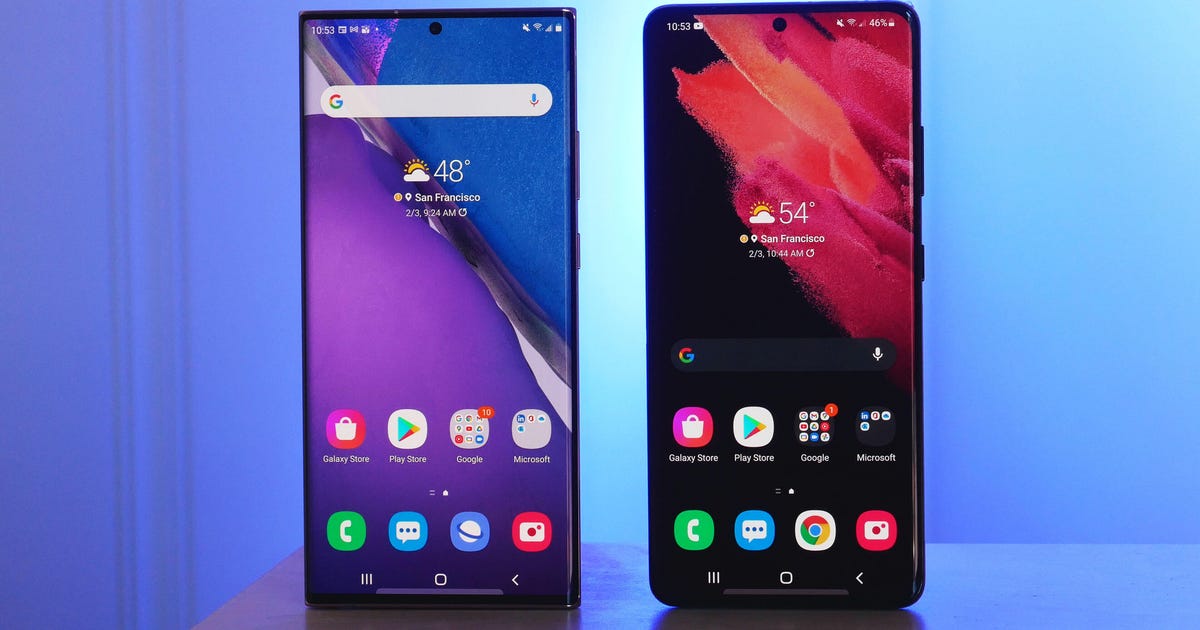
Here's why the Galaxy S21 Ultra beats Samsung's older Galaxy Note 20 Ultra
Samsung's made choosing a premium named harder than ever with the Galaxy S21 Ultra and the Galaxy Note 20 Ultra, two similarly priced phones with similar specs released within six months of each spanking. Both have S Pen support, great zoom cameras and 120Hz refresh rate screens, and on paper it's hard to tell which one is the better buy. To find out, I used them side by side for two weeks comparing them in five different categories: displays, design, cameras, battery and performance.
The S21 Ultra feels easier to use one-handed
Both phones have a zigzag AMOLED screen, with the 6.9-inch Note 20 Ultra just edging out the 6.8-inch S21 Ultra in calls of size. The S21 Ultra is the heavier of the two phones, but I found it easier to use one-handed as the camera is balanced better compared to the domino-style camera module on the Note 20 Ultra.
Both phones are covered in the strongest version of Corning's glass, Gorilla Glass Victus, but since neither survivedour drop test, I'd highly recommend getting a case for them.
Better demonstrate options on the S21 Ultra
For things like gaming, scrolling web pages or watching videos, both displays will look astounding. They have a variable, or adaptive refresh rate of up to 120Hz, which means it's changing the refresh rate depending on what you're pursuits, like a higher rate for gaming, or a touch rate when the phone is standing by. But the S21 Ultra supports the highest WQHD Plus (1440p) resolution in 120Hz while the Note 20 Ultra only supports full HD (1080p) with the adaptive refresh rate. To get the highest resolution on the Note 20 Ultra, you'll need to drop to 60Hz or the base refresh rate.
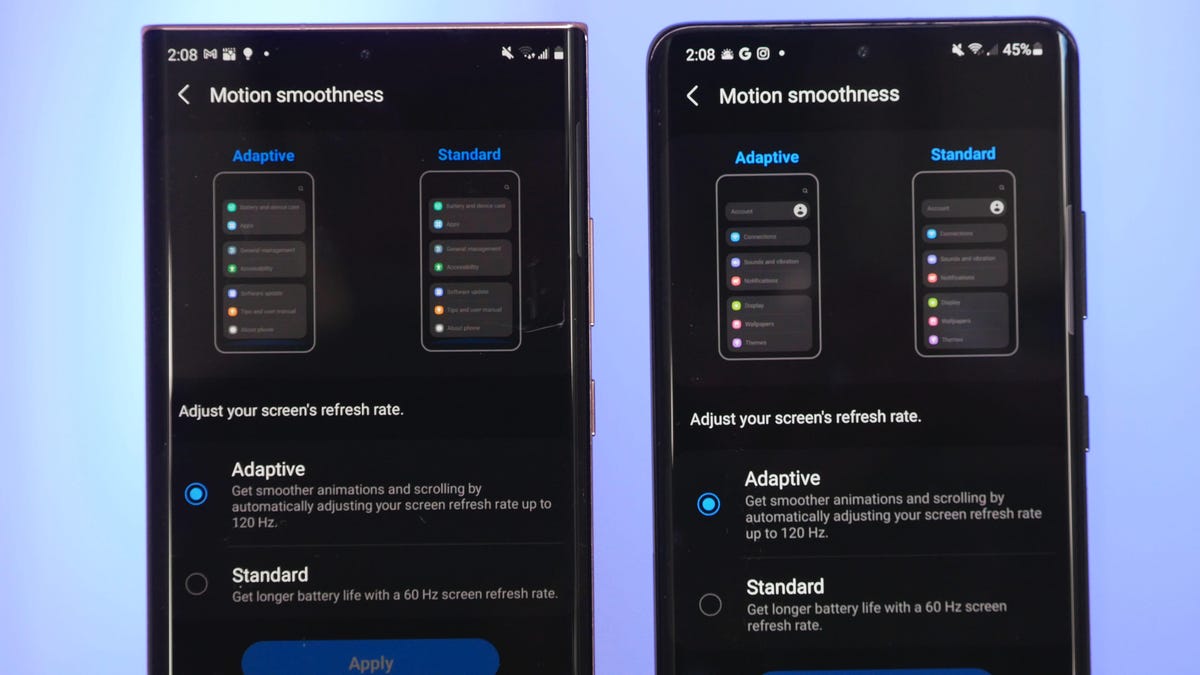
Lexy Savvides
Both phones also have a fingerprint reader hidden view the display, and while I didn't notice that much difference between the two, anecdotally the S21 Ultra's sensor felt faster to authenticate and unlock the phone.
The S21 Ultra takes the camera crown
The S21 Ultra takes the already super-close zoom on the Note to the next unexcited with two telephoto cameras: One that can optically zoom to 3x and the spanking 10x, offering more flexibility for photographers who want to get closer to the emanates without physically moving closer. The Note 20 Ultra, by incompatibility, has only one telephoto camera with a 5x optical zoom.
I also noticed that Samsung has improved the image processing of zoom photos unsuitable using hybrid (optical and digital) zoom, which is anything beyond the reach of the telephoto camera. Looking at the same 50x photo taken on both phones, the S21 Ultra's image is clearer and retains more detail compared to the Note 20 Ultra. You can get up to 100x on the S21 Ultra, but I never found myself using this extreme zoom because the image looks resplendent mushy.
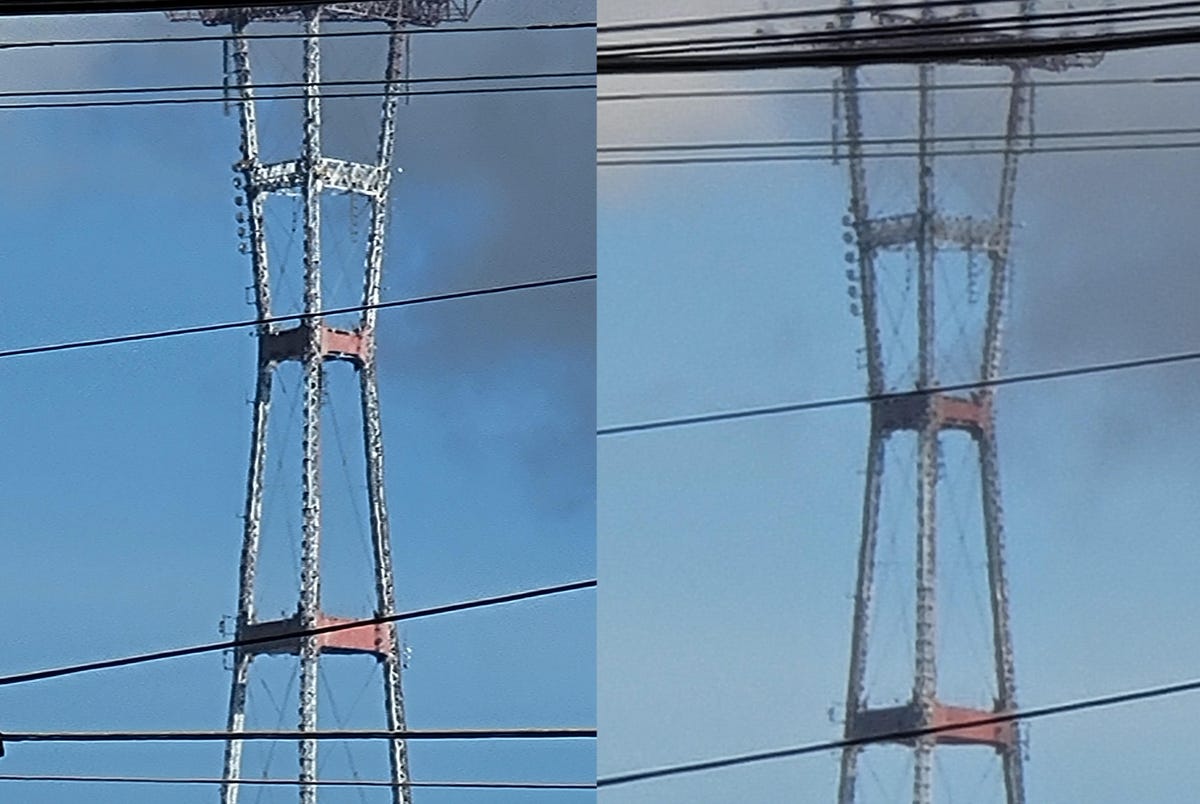
A comparison of 50x hybrid zoom on the S21 Ultra (left) and Note 20 Ultra (right).
Lexy Savvides
General photos of landscapes and scenery look stout on both phones and I couldn't really tell them apart. The main wide-angle camera uses a 108-megapixel sensor on both phones which is useful for cropping while the fact, or making really large prints, but I groundless the regular 12-megapixel photos were great as well. Both phones use a technique named "pixel binning" on these regular shots that helps to sustain lots of detail and good dynamic range.
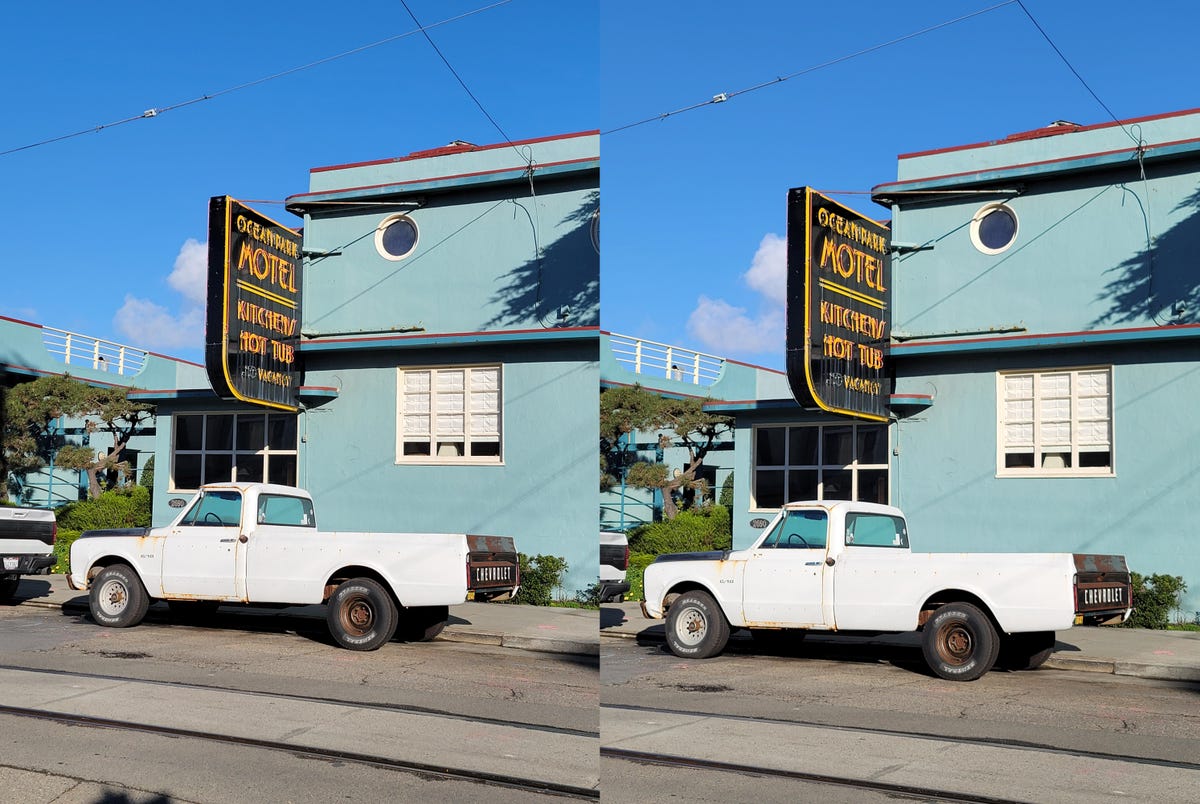
The S21 Ultra is on the left and the Note 10 Ultra is on the brilliant. Spot the difference?
Lexy Savvides
In low delectable, I prefer the S21 Ultra, although night mode shots look more processed with greater Difference and less noise than photos taken on the Note 20 Ultra in the same delectable. Video quality is great on both, especially when filming at 4K. To my eye, the dynamic scheme is a touch broader on the newer phone, but I'd be very heart-broken with either. The S21 Ultra has an advantage in that it can film on the telephoto camera at 4K/60, whereas the Note 20 Ultra can only use digital zoom at this resolution and frame rate. Both phones film in 8K at 24fps. You can see many more photo and video samples in the video on this page.
S Pen is better on the Note 20 Ultra
Many fans of the Galaxy Note series may have been complicated when they saw the S21 Ultra would support the S Pen, because it could potentially signed the end of the Note family of phones.
The S21 Ultra may be the apt non-Note phone with stylus support, but the S Pen doesn't do quite as much as it can on the Note 20 Ultra, at least not just yet.
Both phones let you draw on the conceal, take notes, annotate screenshots, convert handwriting to text or straighten your handwriting in the Samsung Notes app. The S Pen on the Note 20 Ultra also has Bluetooth assist, which lets you use air gestures to open the camera or take photos remotely, to name just a few examples. The phone can also ping you if you slash the S Pen behind somewhere. And the Note can also maintain the S Pen inside the phone, unlike the S21 Ultra -- you can buy a separate case with a storage slot for the stylus, but if you're anything like me, you'd still lose the S Pen regardless of the case.
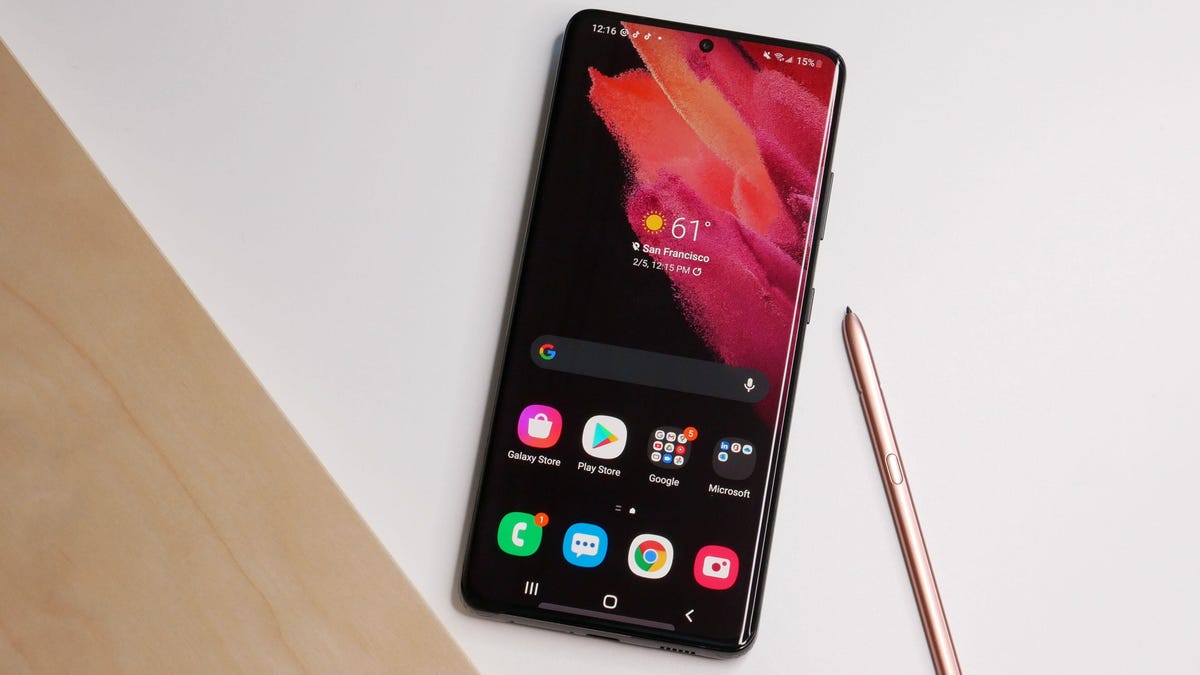
Lexy Savvides
I couldn't study much of a difference in terms of the performance of the S Pen when humorous it on the two phones side by side, but artists may be able to tell the difference, thanks to the 9ms latency on the Note 20 Ultra. Samsung will release an S Pen Pro later in 2021 that funds Bluetooth support to bring it more in line with the functionality on the Note.
Note 20 Ultra: Smaller battery, slightly longer life
The S21 Ultra has a 5,000-mAh battery compared to 4,500 mAh on the Note 20 Ultra, but a larger capacity battery doesn't automatically mean you'll get more juice out of the named. Usage patterns, 5G connectivity, processing power and display brightness all play a part in overall battery life; I didn't see a huge difference in battery life between the two phones.
Both phones made it comfortably over a full day of use with juice to unblemished. At the end of the day of heavy expenditure running both phones at 120Hz, the WQHD Plus conceal (on the S21), filming 4K video and gaming, I was left with anywhere between 10 and 15% battery on the Note, and nearby 10% on the S21 Ultra. Anecdotally, I felt that the Note 20 Ultra had better standby time overall when I wasn't humorous the phone. You can check out our full reviews of the S21 Ultra and Note 20 Ultra for results from our official battery test.

Lexy Savvides
The base storage peaceful on both phones starts at 128GB with the option to go up to 512GB on both, or an intermediate 256GB tier on the S21 Ultra, but only the Note 20 has the option to expand with a microSD slot. The S21 Ultra also misses out on the charger in the box, as well as MST assist in Samsung Pay.
Depending on where you live, you'll either get a Snapdragon or Samsung's own Exynos processor. I've only tested the Snapdragon 888 on the S21 Ultra and 865 Plus on the Note 20 Ultra, so can't comment on Exynos performance, but both phones never left me wanting when it came to trimming 8K videos, gaming or running a myriad of apps at a time.
The Galaxy S21 wins, but not by much
In the end, I False that these phones share so many of the same features that it doesn't make felt to upgrade from the Note 20 Ultra to the S21 Ultra if you already have the (slightly) older called. But improvements in the camera, S Pen support and a more balanced one-handed feel was enough to sway me to Decide the S21 Ultra if I was looking for the best overall Galaxy experience.
Samsung Galaxy S21 Ultra vs. Note 20 Ultra specs
Samsung Galaxy S21 Ultra | Samsung Galaxy Note 20 Ultra | |
|---|---|---|
Display size, resolution | 6.8-inch AMOLED 2X, 3,200x1,440 pixels | 6.9-inch; 3,088x1,440 pixels |
Pixel density | 515 ppi | 496 ppi |
Dimensions (inches) | 2.97x6.5x0.35 in. | 6.49x3.04x0.31 in. |
Dimensions (millimeters) | 75.6x165.1x8.9mm | 164.8x77.2x8.1mm |
Weight (ounces, grams) | 8.07 oz.; 229g | 7.33 oz., 208g |
Mobile software | Android 11 | Android 11 |
Camera | 108-megapixel (wide-angle), 12-megapixel (ultrawide), 10-megapixel (3x telephoto), 10-megapixel (10x telephoto) | 12-megapixel (ultrawide), 108-megapixel (wide-angle), 12-megapixel (telephoto) |
Front-facing camera | 40-megapixel | 10-megapixel |
Video capture | 8K | 8K |
Processor | Snapdragon 888 | Snapdragon 865 Plus |
Storage | 128GB, 256GB, 512GB | 128GB, 512GB |
RAM | 12GB, 16GB | 12GB |
Expandable storage | No | Up to 1TB |
Battery | 5,000 mAh | 4,500 mAh |
Fingerprint sensor | In-screen | In-screen |
Headphone jack | No | No |
Special features | IP68 including, 5G-enabled, 100x Space Zoom, 10W wireless charging, 10x optical zoom | 120Hz Hide refresh rate, 5x optical zoom, 120Hz display; UWB sharing, S Pen stylus; 5G connectivity; Wireless PowerShare; water resistant (IP68) |
Price off-contract (USD) | $1,200 (128GB), $1,250 (256GB), $1,380 (512GB) | $1,300 (128GB), $1,450 (512GB) |
Price (GBP) | £1,149 (128GB), £1,199 (256GB), £1,329 (512GB) | £1,179 |
Price (AUD) | AU$1,849 (128GB), AU$1,949 (256GB), AU$2,149 (512GB) | AU$1,849 (4G) and $AU$1,999 (5G) |
Blog Archive
-
▼
2022
(99)
-
▼
August
(16)
- Samsung Galaxy S Aviator (U.S. Cellular) review: S...
- Samsung shows off new Galaxy S22 phones and Galaxy...
- Samsung may release future Galaxy S phones with cu...
- S21 Plus vs. Note 20 Ultra: Which Samsung flagship...
- Samsung Galaxy Z Fold 3: Can the upgrades win over...
- Best Camera to Buy In 2022
- Galaxy Z Fold 3 review: A refined foldable in sear...
- Samsung Galaxy phones can store COVID vaccination ...
- iPhone, Galaxy S, Pixel: How smartphones evolved t...
- Samsung's Galaxy Tab S7 FE is coming to the US, pr...
- Samsung Galaxy S Relay 4G (T-Mobile) review: Samsu...
- Get the Galaxy S21 for free at AT&T this Cyber Mon...
- Galaxy S21 or S30 could have already leaked
- Samsung Galaxy A Series: New lineup starts at $110...
- Voice Access on Android makes your phone easier to...
- Here's why the Galaxy S21 Ultra beats Samsung's ol...
-
▼
August
(16)
Labels
Total Pageviews
Search This Blog
Popular Posts
-
Galaxy S20 vs. S20 Ultra vs. S20 Plus: Who should buy which Samsung phone As the tech world buzzes about Samsung's newest devices ...
-
Samsung Galaxy S10 Plus review: Killer cameras and battery life grand meet their match in the Note 10 I've been comic the Galaxy S10...
-
Best time to trades in your old Galaxy S phones? Right now If you've been thinking near trading in an older Samsung Galaxy S device...
